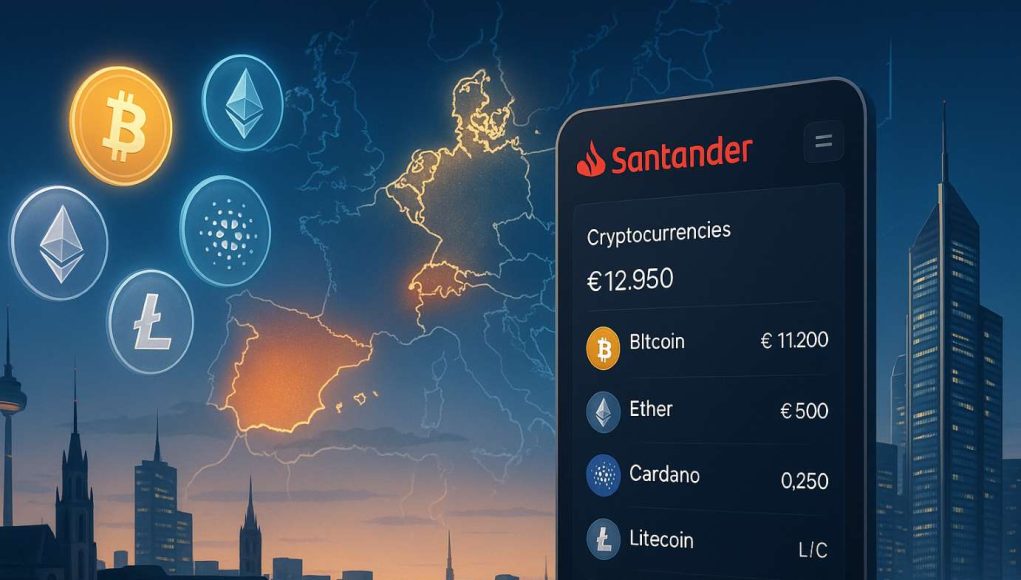Banco Santander’s digital subsidiary, Openbank, has taken its first step into retail crypto trading. Santander’s Openbank crypto service is now live for clients in Germany and will expand into Spain in the coming weeks. Digital assets are integrated directly into the bank’s mobile app, showing how mainstream financial institutions are moving to meet growing demand for crypto in a regulated environment.
Santander’s Digital Arm Moves Into Crypto
Openbank, Santander’s fully online bank, is known for blending traditional services with digital-first convenience. By adding cryptocurrency trading to its product suite, the bank positions itself at the intersection of fintech and traditional finance. Introducing digital assets through Openbank provides a safe entry point into crypto for Santander’s European retail customers. This expansion is also part of Santander’s broader crypto services strategy for retail banking.
What Customers Can Expect
The new service supports five cryptocurrencies at launch: Bitcoin, Ether, Litecoin, Polygon, and Cardano. Trading is handled directly inside the Openbank app, alongside investments in funds, ETFs, and stocks. Clients pay a 1.49% fee per transaction with a minimum of €1, while custody is offered free of charge. Santander also plans to expand its token selection and add crypto-to-crypto conversions in future updates. Including Cardano and Polygon in the Santander Openbank crypto launch highlights the bank’s intent to go beyond Bitcoin and Ether.
Why the Santander Openbank Crypto Launch Matters for Europe
For years, retail crypto trading in Europe has largely been the domain of exchanges and neobanks. Santander’s move changes that equation. By embedding digital assets in a bank-owned platform, Openbank lowers barriers for everyday clients. Many prefer the security and familiarity of a regulated institution. This shift aligns with wider fintech trends, where users expect access to both traditional and digital investments in one place.
>>> Read more: Santander Stablecoin Launch: MiCA-Compliant Crypto for Retail
Regulation as the Foundation
A key enabler of the rollout is the EU’s Markets in Crypto-Assets (MiCA) regulation. It offers banks a clear framework to integrate crypto services. Santander highlights investor protection and compliance as central to Openbank’s design. With MiCA allowing regulatory passporting, Openbank can expand its crypto services across Europe, provided local approvals are granted.
Competing With Fintechs and Exchanges
Openbank’s crypto entry places it in direct competition with platforms like Revolut, Coinbase, and Binance. Its 1.49% trading fee is higher than many exchange offerings. Still, the appeal lies in convenience, regulatory safeguards, and integration with existing accounts.
The comparison of Revolut vs Santander crypto fees shows a clear gap. Revolut can be cheaper for premium users. Santander’s Openbank, however, offers the advantage of bank-backed crypto trading under MiCA rules.
The Coinbase vs Openbank crypto comparison highlights another trade-off. Coinbase offers lower fees, while Openbank provides stronger regulatory assurance.
Asset Choices and Market Impact
The decision to include Cardano and Polygon alongside Bitcoin and Ether shows a strategy that goes beyond the market leaders. Crypto analysts expect that Cardano’s listing in the Santander Openbank crypto launch will increase visibility for ADA in Europe. The same is true for Polygon’s MATIC token. This selection reflects Santander’s intent to make Openbank a comprehensive gateway to the digital asset market, not just a Bitcoin on-ramp.
>>> Read more: BBVA Crypto Services: Pioneering Digital Asset Trading in Spain
The launch of crypto trading by Santander’s Openbank marks a milestone in Europe’s financial landscape. By combining the trust of a major bank with the flexibility of a digital platform, the Santander Openbank crypto rollout is pushing digital assets further into the financial mainstream. Germany is the starting point, Spain is next, and with MiCA regulation smoothing the path, wider European expansion looks inevitable.
Readers’ frequently asked questions
What fees apply to crypto trading on Santander’s Openbank?
Openbank charges a 1.49% fee per transaction with a minimum of €1. There are no custody or holding fees for keeping your digital assets within the bank’s platform.
Can I transfer my crypto out of Openbank to an external wallet?
No. At launch, the service only supports buying, selling, and holding crypto within the Openbank app. Transfers to external wallets are not available, though Santander has signaled that additional features may be added in the future.
When will Openbank’s crypto service expand beyond Germany and Spain?
The rollout in Germany is live, and Spain is expected to follow shortly. Wider European expansion will depend on regulatory approvals under the EU’s MiCA framework, which enables banks to passport crypto services across member states.
What Is In It For You? Action items you might want to consider
Compare Openbank’s crypto fees with other platforms
If you’re based in Germany or Spain, check how Openbank’s 1.49% fee compares with Revolut, Coinbase, or Binance. For small trades, the cost may not differ much, but frequent traders could save significantly elsewhere.
Evaluate the benefits of a bank-backed service
Consider whether the added trust, MiCA compliance, and direct banking integration offset the higher trading fees. For newcomers to crypto, the security of using a bank may outweigh cost differences.
Track Openbank’s expansion across Europe
Spain will be next, but MiCA passporting could bring this service to other EU countries soon. Monitoring which markets Santander’s Openbank enters first can help crypto traders anticipate local opportunities and competition.










